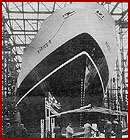|

World War I dealt the Greek merchant marine a heavy blow. From the 475 ships under Greek ownership (with a total tonnage of 900,000) in 1915, only 115 survived (with a tonnage of 126,000) in 1918. Recovery however, was impressive during the interwar period. By 1938, Greece had  more than 6900 ships, with a total tonnage in the order of 1,870,000. Therefore, it held the tenth place in the world for tonnage and the third for tonnage per capita of its population. 90% of the Greek ships were seagoing merchant ships. There were also 700 sailing vessels that transported people and goods along the coast or between the islands and the mainland. Three quarters of the ships were older than twenty years, because the purchase of second-hand ships by shipowners constituted the base of the Greek practice. The structure of family ownership allowed a margin of profit, as well as the undertaking of risks that shipowners of other more developed countries, with other systems of maritime ownership, could not undertake. more than 6900 ships, with a total tonnage in the order of 1,870,000. Therefore, it held the tenth place in the world for tonnage and the third for tonnage per capita of its population. 90% of the Greek ships were seagoing merchant ships. There were also 700 sailing vessels that transported people and goods along the coast or between the islands and the mainland. Three quarters of the ships were older than twenty years, because the purchase of second-hand ships by shipowners constituted the base of the Greek practice. The structure of family ownership allowed a margin of profit, as well as the undertaking of risks that shipowners of other more developed countries, with other systems of maritime ownership, could not undertake.
The most important shipping centres, where Greek shipowners pursued their activity in 1938, were located in England (London was the main one). Next to these were certain large ports in France, Romania and Egypt. To demonstrate the geographical width of Greek  marine activation, it should be mentioned that there were 19 ships of Greek ownership (weighing 43,000 tons) in Shanghai, performing itineraries exclusively within China. Among the Greek ships under a foreign flag of convenience, most of them used the Panamanian flag. The most important port sheltering Greek owned ships was Piraeus. Next came Andros, Chios and Syros, which was also a major bunkering port (that is a port for fuel supply). In the list of Greek shipowners in 1938 I. Kouloukoundis held the first place and N. G. Livanos the second. In general, the big names of shipowners during the interwar period did not differ from the ones of today: Chandris, Empeirikos, Goulandris, Nikolaou, Nomikos, Rethymnis etc. marine activation, it should be mentioned that there were 19 ships of Greek ownership (weighing 43,000 tons) in Shanghai, performing itineraries exclusively within China. Among the Greek ships under a foreign flag of convenience, most of them used the Panamanian flag. The most important port sheltering Greek owned ships was Piraeus. Next came Andros, Chios and Syros, which was also a major bunkering port (that is a port for fuel supply). In the list of Greek shipowners in 1938 I. Kouloukoundis held the first place and N. G. Livanos the second. In general, the big names of shipowners during the interwar period did not differ from the ones of today: Chandris, Empeirikos, Goulandris, Nikolaou, Nomikos, Rethymnis etc.
As far as the personnel of ships was concerned, according to the muster roll of 1928 there were 34,000 seamen, among which (according to data provided in 1934) 7500 were merchant navy officers. In 1936 there were 4 schools of merchant navy officers in Greece (Naval Intelligence Division, Greece, vol. II, Geographical Handbook Series, Norwich, Oktober, 1944, p. 196-223). The importance of the Greek merchant fleet became the object of Britain's interest. That is the reason why, before the beginning of World War II, Britain requested to hire the entire Greek fleet. |


